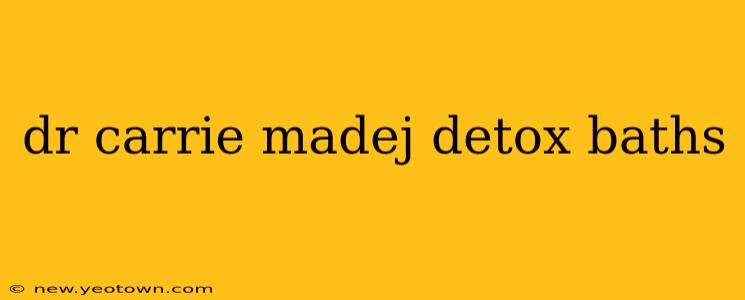Dr. Carrie Madej Detox Baths: Separating Fact from Fiction
Dr. Carrie Madej, a physician known for her controversial views on vaccines and other medical topics, has promoted the use of detox baths as a way to remove toxins from the body. While the concept of detoxification is appealing, the scientific evidence supporting Dr. Madej's specific bath formulations and claims is lacking. This article explores the claims surrounding Dr. Madej's detox baths, examining the science behind detoxification and the potential benefits and risks associated with these practices. We'll delve into common questions surrounding this topic.
What are Dr. Carrie Madej's detox bath ingredients?
Dr. Madej's recommended detox bath recipes often include ingredients like Epsom salts, baking soda, bentonite clay, and essential oils. She often emphasizes the purported ability of these ingredients to draw out "toxins" from the body through the skin. However, it's crucial to understand that the skin acts as a barrier, preventing the absorption of most substances. While some minerals like magnesium (from Epsom salts) can be absorbed through the skin, the extent to which this impacts overall detoxification is debatable. The effectiveness of these baths in removing harmful substances from the body is not supported by robust scientific evidence.
Do detox baths actually work?
The idea of detoxifying the body through baths is appealing, but the human body already possesses highly efficient detoxification systems: the liver, kidneys, and lymphatic system. These organs work tirelessly to filter and eliminate waste products. While a warm bath can be relaxing and offer some therapeutic benefits, there's no scientific evidence to suggest that it can significantly remove toxins from the body at the level claimed. The concept of "detoxing" often exploits anxieties surrounding environmental toxins and industrial chemicals without a strong scientific basis.
What are the benefits of Epsom salt baths?
Epsom salt baths, containing magnesium sulfate, are often touted for their relaxing properties and potential benefits for muscle soreness and inflammation. Magnesium, an essential mineral, may be absorbed through the skin, contributing to relaxation and potentially aiding in muscle recovery. However, the amount absorbed through the skin is likely relatively small compared to dietary sources. While Epsom salts may offer some soothing benefits, they shouldn't be considered a primary method of detoxification.
Are there any risks associated with detox baths?
While generally considered safe for most individuals, detox baths can pose risks. Some individuals may experience skin irritation or allergic reactions from certain ingredients, especially essential oils or clays. Those with pre-existing skin conditions should exercise caution and consult their doctor before using detox baths. Additionally, relying solely on detox baths for detoxification and neglecting standard medical advice is ill-advised.
Are there natural ways to support detoxification?
Supporting your body's natural detoxification processes focuses on healthy lifestyle choices. A balanced diet rich in fruits, vegetables, and whole grains, regular exercise, sufficient hydration, and adequate sleep are far more effective than any purported "detox" bath. Focusing on these aspects promotes overall well-being and supports the optimal function of the liver and kidneys.
Disclaimer: This information is for educational purposes only and does not constitute medical advice. Always consult with a healthcare professional before starting any new health regimen, especially if you have underlying health conditions. Be wary of unsubstantiated claims regarding "detoxification" products and focus on scientifically-backed methods to maintain your health.

